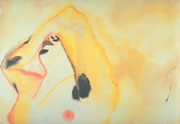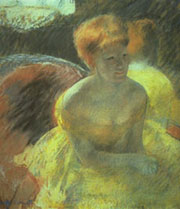 |
|
What is "Color"? |
|
 |
|
Technically, color is the manifestation of the various wavelengths of light. That is, blue corresponds to a specific wavelength of light as do red and yellow. The physics behind light and color may not seem immediately relevant to artists, but it is helpful to remember that light moves and changes direction and that color corresponds to these changes in direction. Therefore, if we think of light shining on an object--a cube, for example--the color of each plane of the object will be different from one another because each plane has a specific relationship to the light unlike any of the other planes. In other words, color is a product of relationships between form and light.
|
|
 |
|
Clemente
|
|
|
What does Color do? |
|
. |
|
Color describes, much in the same way lines and marks do and value does. The greater the range of color we use, the more descriptive we can be. In fact, if we consider the color spectrum theoretically, an infinite number of colors can exist. Using many colors is like being able to speak with a broad vocabulary.
Range in color is achieved through mixing. Mixing styles include:
| Additive |
mixing of light, producing slightly lighter values |
| Subtractive |
mixing of pigments, producing slightly darker values |
| Optical |
visual mixing, positioning of colors allows the viewer to perceive different colors |
Color can also express temperature such as warm or cool. Temperature characteristics, in turn, can communicate sensations of distance: warmer colors appear to advance, cooler colors appear to recede.
Color is also capable of delivering psychological, emotional, and/or symbolic, intellectual meaning. Color achieves these effects mostly by referencing widely understood objects or experiences: for example, red like blood, green like nature.
|
|
 |
|
Edgar Degas
|
|
|
|
|
 |
|
|
|
|
|
